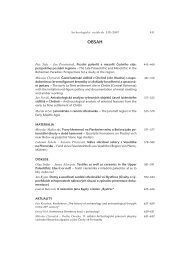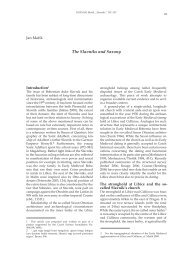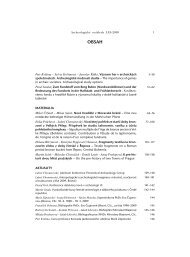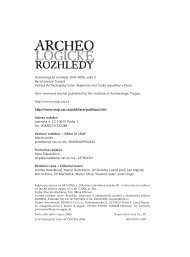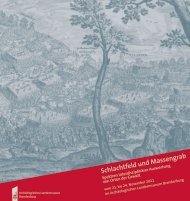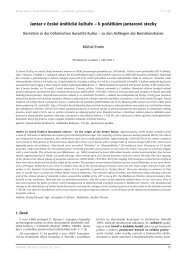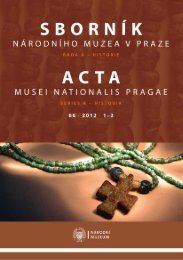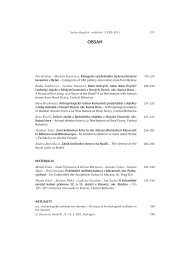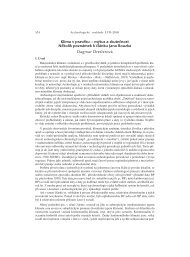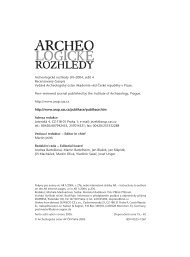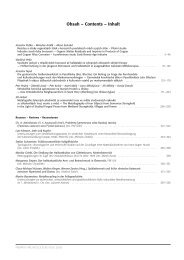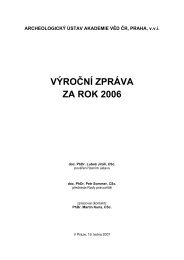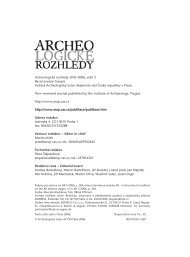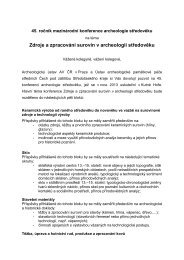2003_2 - Archeologický ústav AV ČR
2003_2 - Archeologický ústav AV ČR
2003_2 - Archeologický ústav AV ČR
You also want an ePaper? Increase the reach of your titles
YUMPU automatically turns print PDFs into web optimized ePapers that Google loves.
Archeologické rozhledy LV–<strong>2003</strong> 263Thieme, H. – Veil, S. 1985: Neue Untersuchungen zum eemzeitlichen Elefant–Jagdplatz Lehringen, Ldkr.Verden, Die Kunde N. F. 36, 11–58.Valoch, K. 1996: Le Paléolithique en Tchéquie et en Slovaquie. Jérôme Millon, Grenoble.— 1997: Bone Modification in the Moravian Lower and Middle Paleolithic and Problems associated withextensive Bone Accumulations of Large Mammals. In: L. A. Hannus et al. eds., Proceedings of the 1993Bone Modification Conference, Hot Springs, South Dakota, Augustana College, Sioux Falls, 76–87.Vasilev, S. A. 2001: Man and Mammoth in Pleistocene Siberia. In: Cavarretta et al. eds. 2001, 363–366.Velichko, A. A. – Zelikson, E. M. 2001: Landscape, climate and mammoth food resources in the East Europeanplain during the Late Paleolithic. In: Cavarretta et al. eds. 2001, 724–727.Vencl, S. 1977: Nejstarší osídlení Hradce Králové, Archeologické rozhledy 29, 303–309.Vereščagin, N. K. 1977: Berelechskoje „kladbišče“ mamontov. In: A. O. Skarlato ed., Mamontovaja faunarusskoj ravniny, Trudy Zool. inst. 72, Nauka, Leningrad, 5–50.Vereschagin, N. K. – Baryshnikov, F. C. 1982: Paleoecology of the mammoth fauna in the Eurasian Arctic.In: Hopkins et al. eds. 1982, 267–280.Vlček, E. 1961: Pozůstatky mladopleistocénního člověka z Pavlova, Památky archeologické 52, 46–56.de Vore, I. 1968: Comments. In: S. R. Binford – L. R. Binford eds., New perspectives in archeology, Chicago,346–349.Wankel, J. 1884: První stopy lidské na Moravě, Časopis Vlasteneckého musejního spolku olomouckého 1,2–7, 41–49, 89–100.— 1890: Ložiska mamutí v Předmostí, Časopis Vlasteneckého musejního spolku olomouckého 7, 1–10,53–64.West, D. L. 2001a: Analysis of the Fauna recovered from the 1986/1987 excavations at Dolní Věstonice II,western slope, Památky archeologické 92, 98–123.— 2001b: Mammoth Hunting or Scavenging During the Upper Paleolithic? In: West ed. 2001, 57–67.West, D. L. ed. 2001: Proceedings of the International Conference on Mammoth Site Studies. University ofKansas, Lawrence.Wojtal, P. 2001: The wooly mammoth (Mammuthus primigenius) remains from the Upper Palaeolithic siteKraków Spadzista Street (B). In: Cavarretta et al. eds. 2001, 367–372.— 2002: New excavations at Kraków Spadzista Street (B) site. In: The Gravettian along the Danube.Abstracts, Mikulov, 11.Wojtal, P. – Cyrek, K. – Sytnik, A. 2001: The New Upper Palaeolithic mammoth site at Halich (Ukraine), Actazoologica Cracoviensia 42, 137–142.Wood, J. G. 1868: The natural history of man, Vol. I: Africa. Routledge, London.Zawisza, J. 1878: La caverne du Mammouth en Pologne. In: Mémoires de la Société d’Anthropologie deParis 2, Paris, 439–447.Zelenin, D. K. 1936: Kult ongonov v Sibiri. Moskva – Leningrad.On the importance of mammoth bone accumulations,or wits’ end with “science“The archaeological thought of the last two decades has left conspicuous traces in attempts todraw closer to an interpretation of observed facts of authentic samples of human behaviour, as isknown both from ethnological observation and from the somewhat more general concerns of culturalanthropological studies. It seems that the archaeology of the Palaeolithic is that attempt to humaniseinterpretations which is the least successful. Pleistocene archaeology is the most dependenton the natural sciences, which are understood by many as disciplines which are not auxiliary butdeterminative, and who thus cling to their approaches. A number of celebrated specialists in thePalaeolithic have been recruited from the ranks of natural scientists, or graduated in the naturalsciences (in this country K. Absolon and B. Klíma, for instance). The subject of interest of Palaeolithicarchaeology is at the same time divided from sub–recent ethnological observation by thelongest interval, and thus among archaeologists as a whole it is those who study the Palaeolithicthat are in the greatest danger of rebuke for comparing the incomparable.



